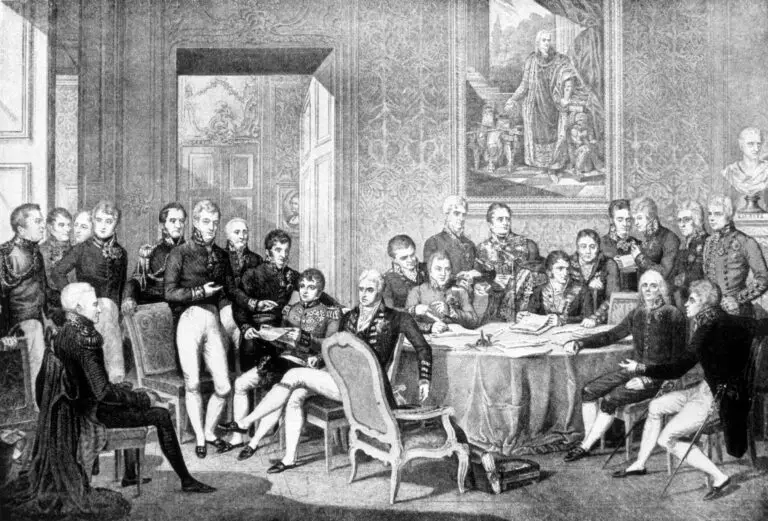Congress of Vienna

Table of Contents
Congress of Vienna Overview
The Congress of Vienna convened in 1814-1815, and it was a diplomatic gathering of major European powers with the primary objective of restructuring and stabilizing Europe in the aftermath of the Napoleonic Wars.
Led by key statesmen, including Klemens von Metternich of Austria, Viscount Castlereagh of Great Britain, Tsar Alexander I of Russia, and Prince Talleyrand of France, the congress aimed to restore a balance of power, maintain peace, and prevent future conflicts. The negotiations resulted in a comprehensive reorganization of European territories, redrawing national boundaries and reinstating monarchies disrupted by Napoleon’s conquests.
The Congress of Vienna established a system of diplomatic equilibrium known as the Concert of Europe, where major powers collaborated to address political issues and maintain stability, influencing European politics for much of the 19th century. While criticized for its conservatism and disregard for nationalist aspirations, the Congress of Vienna played a crucial role in shaping the post-Napoleonic order and fostering a period of relative peace in Europe.
Congress of Vienna Events
The Congress of Vienna took place from September 1814 to June 1815 and was a diplomatic conference held in Vienna, Austria, involving representatives from major European powers.
The Congress aimed to reorganize and redraw the map of Europe after the Napoleonic Wars and the downfall of Napoleon Bonaparte.
The primary architects of the Congress of Vienna were the “Big Four” powers: Austria, Britain, Prussia, and Russia, with key diplomats such as Klemens von Metternich of Austria playing a central role.
The Congress sought to establish a balance of power in Europe to prevent the rise of a single hegemonic state and maintain stability.
The principle of legitimacy, emphasizing the restoration of hereditary monarchies and legitimate rulers, was a key guiding principle of the Congress.
The concept of compensation was employed, whereby territories seized during the Napoleonic Wars were redistributed among the victorious powers in a way that sought to maintain a balance.
The Holy Alliance, a conservative political coalition formed by Austria, Prussia, and Russia, sought to uphold Christian principles in governing nations and was associated with the ideals of the Congress of Vienna.
France, despite being defeated in the Napoleonic Wars, was treated with relative leniency at the Congress of Vienna to prevent future conflict and maintain stability in the region.
The Congress established the German Confederation, a loose association of German states, under Austrian leadership, as part of the effort to reorganize the political landscape in Central Europe.
The Congress of Vienna is considered a successful example of diplomatic balance, as it managed to establish a relatively stable European order that lasted for several decades.
Related Links
Ancient Mesopotamia
Napoleonic Wars
Unification of Germany
Ottoman Empire